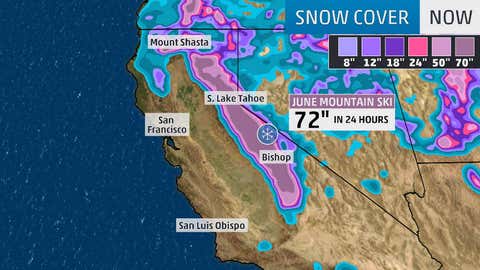
At a Glance
- June Mountain in the Sierra Nevada picked up 6 feet of snow in 24 hours.
- Its storm-total snowfall tallied 8 feet in less than three days.
- The ski resort was closed on Monday because of all the snow.
Incredible amounts of snow have fallen throughout parts of the Mountain West since last Friday after a one-two punch from winter storms Kai and Lucian. The Sierra Nevada, straddling the border between California and Nevada, has been particularly hard-hit, where one ski resort tallied 6 feet of snow in just one day.
Taking that crown is June Mountain, east of Yosemite National Park. June Mountain reported 72 inches of new snow in the 24 hours ending 9 a.m. PST Sunday morning.

It should be noted the June Mountain 24-hour total is an unofficial measurement and won't be included in NOAA's climate records.
The official 24-hour snowfall record for California is 67 inches, measured at Echo Summit, a mountain pass south of Lake Tahoe, on Jan. 5, 1982.
(MORE: The Greatest 24-Hour Snowfalls in All 50 States)
The storm-total snowfall at June Mountain from Friday through mid-morning Sunday was measured at 96 inches, according to the National Weather Service in Reno, Nevada.
Yes, that's 8 feet of snow in less than three days. And it was too much for the ski resort to handle; June Mountain was closed on Monday as workers attempted to dig out, the resort said in a Facebook post.
That got us thinking – what are some of the heaviest snowfall records in United States history? Below, we take a look at a few of the known records, including the heaviest monthly, seasonal and 24-hour snowfall amounts.
(MORE: Snowiest Location in Every State)
Most Snow Measured in a Month: 390 Inches

Tamarack, California, holds the record for the most snow in a calendar month, with 390 inches (32.5 feet) in January 1911. That is nearly twice the average snowfall during an entire winter in very snowy Marquette, Michigan, which averages about 204 inches annually.
Tamarack's location high in the Sierra Nevada makes it an ideal spot to intercept copious amounts of moisture provided by an active storm track off the Pacific Ocean. The site of this record is at an elevation of 7,000 feet, near where the Bear Valley Ski Resort is now, according to Christopher Burt of Weather Underground.
Biggest Seasonal Snowfall Total: 1,140 Inches

An incredible 1,140 inches (95 feet) was recorded at Mount Baker Ski Area (elevation: 4,200 feet) during the July 1, 1998 to June 30, 1999 snow season.
For perspective, that snow total is equal to the height of nine to 10 basketball goals stacked on top of each other, or the distance on a football field from the goal line to just past the 30-yard line.
Most Snow Measured in 24 Hours: 75.8 Inches
If you are 6 feet tall and stood outside for 24 hours in Silver Lake, Colorado, April 14-15, 1921, you would've been buried by snow from head to toe. That location recorded 6.3 feet of snow in a single day at an elevation of 10,220 feet in the Colorado Rockies.
In 1997, a report of 77 inches of snow measured in 24 hours in Montague, New York, east of Lake Ontario on the Tug Hill Plateau, was submitted for review by NOAA to see if the Silver Lake record was defeated. A committee reviewed the report and determined the Silver Lake record should remain after finding proper climatological guidelines were not used to measure the snow in Montague.
Most Snow in Two Days: 120.6 Inches
Thompson Pass, Alaska, holds the record for the most snow in a two-day period, according to Burt. Just over 10 feet of snow was measured there Dec. 29-30, 1955.
Thompson Pass is located to the east of Valdez, Alaska, one of the snowiest cities in America.
Most Snow from a Single Storm: 189 Inches

The old Mount Shasta Ski Bowl in Northern California holds the record for the most snow received from a single storm system.
A total of 15.75 feet (189 inches) of snow was measured Feb. 13-19, 1959.
Mount Shasta is a volcano in the Cascade mountain range and rises as high as 14,160 feet. It is the second-highest of 15 main volcanoes in the Cascade range, according to the National Park Service.
Greatest Snow Depth on Record: 451 Inches

Tamarack, California, also holds the U.S. record for greatest snow depth ever measured. A maximum snow depth of 451 inches, or 37.5 feet, was recorded on March 11, 1911. The record monthly snowfall in January of that year helped contribute to the record depth.
Burt researched locations outside the U.S. and found that an even greater snow depth of 465.4 inches was measured Feb. 14, 1927, on Mount Ibuki in Japan (Honshu Island).
Most Snow Measured in One Hour: 12 Inches
Lake-effect snow events dominate the record books when it comes to extreme short-term snowfall amounts.
Burt compiled a list of the record snowfall rates in his book "Extreme Weather," and the top amount in a single hour was 12 inches in Copenhagen, New York, east of Lake Ontario on the Tug Hill Plateau, on Dec. 2, 1966. That same location also picked up 6 inches in 30 minutes during the event.
The record is unofficial, as the National Weather Service does not keep official records on snowfalls of less than 24 hours in duration.
For other extreme snowfalls spanning various time periods, plus an explanation of why snow can be so challenging to measure, see the Weather Underground article by Christopher Burt.



